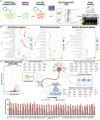Neuro293: A REST-knockout HEK-293 cell line enables the expression of neuron-restricted genes for the high-throughput testing of human neurobiology and the biochemistry of neuronal proteins
- PMID: 40575147
- PMCID: PMC12202048
- DOI: 10.1093/biomethods/bpaf036
Neuro293: A REST-knockout HEK-293 cell line enables the expression of neuron-restricted genes for the high-throughput testing of human neurobiology and the biochemistry of neuronal proteins
Abstract
Efficient interrogation of neurobiology remains bottlenecked by obtaining mature neurons. Immortalized cell lines still require lengthy differentiation periods to obtain neuron-like cells, which may not efficiently differentiate and are challenging to transfect with plasmids relative to other cell lines such as HEK-293's. To overcome challenges with limited access to cells that express mature neuronal proteins, we knocked out the RE1-silencing transcription factor (REST) from HEK-293's to create a novel neuron-like cell, which we name Neuro293. RNA-sequencing and bioinformatics analyses revealed a significant upregulation of genes associated with neurobiology and membrane excitability including pre-/post-synaptic proteins, voltage gated ion channels, neuron-cytoskeleton, as well as neurotransmitter synthesis, packaging, and release. Western blot validated the upregulation of Synapsin-1 (Syn1) and Snap-25 as two neuron-restricted proteins, as well as the potassium channel Kv1.2. Immunocytochemistry against Neurofilament 200 kd revealed a significant upregulation and accumulation in singular processes extending from Neuro293's cell body. Similarly, while Syn1 increased in the cell body, Syn1 protein accumulated at the ends of processes extruding from Neuro293's. Neuro293's express reporter-genes through the Syn1 promoter after infection with adeno-associated viruses (AAV). However, transient transfection with AAV2 plasmids led to leaky expression through promoter-independent mechanisms. Despite an upregulation of many voltage-gated ion channels, Neuro293's do not possess excitable membranes. Collectively, REST-knockout in HEK-293's induces a quickly dividing and easily transfectable cell line that expresses neuron-restricted and mature neuronal proteins which can be used for high-throughput biochemical interrogation, however, without further modifications neither HEK-293's or Neuro293's exhibit properties of excitable membranes.
Keywords: high-throughput testing; mature neuronal proteins; neuronal differentiation; stable cell line.
© The Author(s) 2025. Published by Oxford University Press.
Figures




Similar articles
-
Signs and symptoms to determine if a patient presenting in primary care or hospital outpatient settings has COVID-19.Cochrane Database Syst Rev. 2022 May 20;5(5):CD013665. doi: 10.1002/14651858.CD013665.pub3. Cochrane Database Syst Rev. 2022. PMID: 35593186 Free PMC article.
-
A rapid and systematic review of the clinical effectiveness and cost-effectiveness of paclitaxel, docetaxel, gemcitabine and vinorelbine in non-small-cell lung cancer.Health Technol Assess. 2001;5(32):1-195. doi: 10.3310/hta5320. Health Technol Assess. 2001. PMID: 12065068
-
Comparison of cellulose, modified cellulose and synthetic membranes in the haemodialysis of patients with end-stage renal disease.Cochrane Database Syst Rev. 2001;(3):CD003234. doi: 10.1002/14651858.CD003234. Cochrane Database Syst Rev. 2001. Update in: Cochrane Database Syst Rev. 2005 Jul 20;(3):CD003234. doi: 10.1002/14651858.CD003234.pub2. PMID: 11687058 Updated.
-
Factors that influence parents' and informal caregivers' views and practices regarding routine childhood vaccination: a qualitative evidence synthesis.Cochrane Database Syst Rev. 2021 Oct 27;10(10):CD013265. doi: 10.1002/14651858.CD013265.pub2. Cochrane Database Syst Rev. 2021. PMID: 34706066 Free PMC article.
-
A rapid and systematic review of the clinical effectiveness and cost-effectiveness of topotecan for ovarian cancer.Health Technol Assess. 2001;5(28):1-110. doi: 10.3310/hta5280. Health Technol Assess. 2001. PMID: 11701100
References
LinkOut - more resources
Full Text Sources
Miscellaneous
